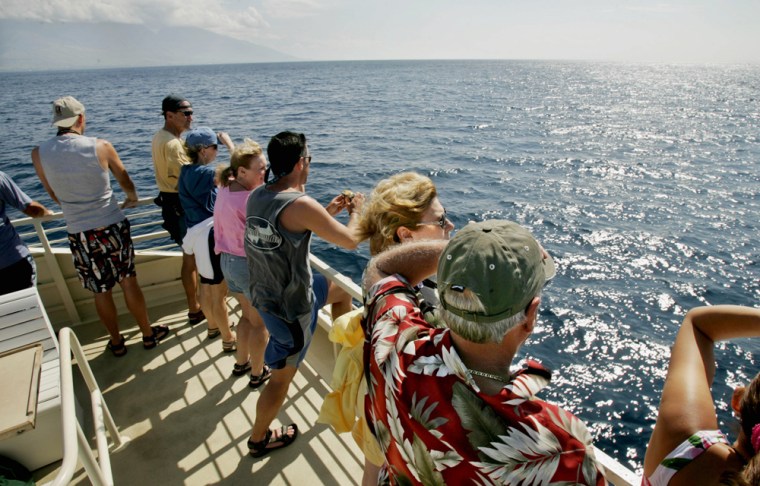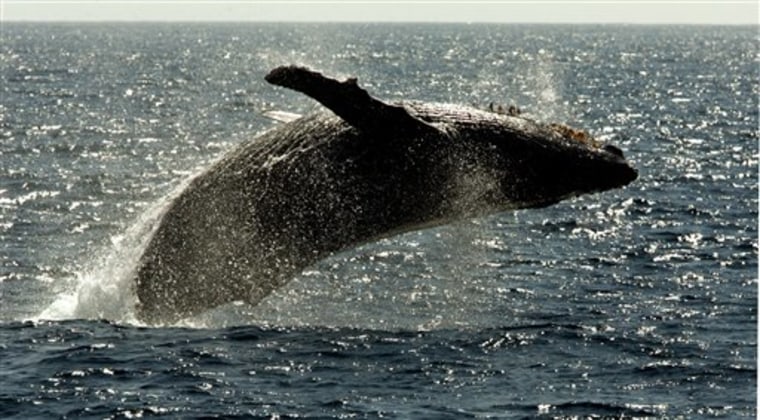Greg Kaufman says his whale-watching boat was doing everything by the book: cruising below 13 knots and staying 100 yards from any visible humpback as a crew member scanned the ocean atop a lookout.
Still, it wasn’t enough to prevent the Pacific Whale Foundation vessel from running over a calf that surged from underneath March 9.
It was one of seven confirmed encounters in the current breeding season, which is drawing to a close but already has set a record for such accidents. Between 1975 and 2005, there were 33 reported strikes involving whales and boats among the islands, with no more than three in one single season.
Environmental groups call the trend alarming, but researchers hope it has more to do with a rebound in the endangered species’ population than with negligent boaters.
“It’s some combination of increasing number of whales and just boats and whales in the same area at the same time,” said Jeff Walters, co-manager of the Hawaiian Islands Humpback Whale National Marine Sanctuary.
1,000 calves at sea
The humpback population roaming the North Pacific, estimated at about 10,000, is believed to have been growing at an annual rate of about 7 percent since the mid-1990s. And as more whales swim to Hawaii from icy feeding grounds off Alaska, Canada, Russia and Japan, boaters are navigating around some 1,000 calves born in Hawaiian waters each year.
“As long as the population continues to get bigger, it’s going to keep happening,” said Joseph Mobley, a professor at the University of Hawaii-West Oahu who researches whales.
About 50 ships are involved in whale watching in Hawaii, carrying 300,000 passengers a year, mostly from Maui.

Calves pose a greater danger because they need to surface more often — about every three to five minutes. But experts say the mothers, who mated here last year, are getting used to the attention and also edging closer to the vessels.
“It’s kind of like driving in a school zone,” said marine biologist David Schofield of the National Oceanic and Atmospheric Administration.
Humpbacks, which were placed under international protection in 1966, are also shielded under federal law. Boat drivers need to follow an “approach rule” that instructs them to travel below 13 knots, never leave the helm, post a lookout and stay 100 yards from whales.
Kaufman said a boat captain was doing just that when a calf surprised everyone aboard the company’s Ocean Spirit during an educational cruise for two schools in Maui.
“No matter how many best practices we put into effect, when one surfaces directly under your boat, there’s nothing you can do about it,” Kaufman said.
Ideas on the table
Jeff Mikulina, director of Sierra Club of Hawaii, said he would like to see stricter enforcement of regulations and perhaps a limitation on the number of boats during the peak breeding season.
“We need to remember that we are the visitors here,” he said.
Scientists are doing research on sonar that would detect whales as far as five miles away, Mobley said. Initial tests have worked in calm waters, but the system may not work in heavy trade winds, which blow regularly in the islands. Propeller guards also could help reduce accidents.
Boat captains are required to notify NOAA officials of any accidents by calling a hot line. All but one of the seven whale collisions this season were reported, and at least three involved whale-watching boats.
It’s unclear what happens to injured whales, which despite their size can quickly disappear, sometimes with fatal gashes and internal wounds. It’s also hard to find 40-ton carcasses, which can sink or be eaten by sharks.
“Almost always we never find them,” said Ed Lyman, who is in charge of NOAA’s response team. “It’s like a needle in a haystack.”
